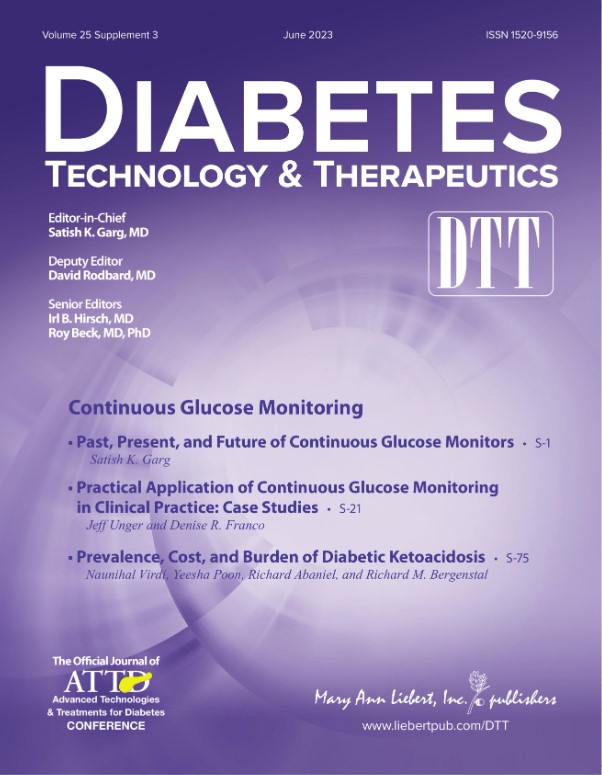Article / Publication
This article reports key findings from recent randomized, observational, and retrospective studies investigating use of CGM in type 2 diabetes (T2D) individuals treated with basal insulin only and/or noninsulin therapies. Data from 29 studies were reviewed and analyzed. Both randomized and prospective/retrospective studies have demonstrated significant glycemic improvement, reductions in diabetes-related events and hospitalization rates, and cost benefits of persistent CGM use by individuals with T2D who are treated with basal insulin only, basal plus noninsulin medications, and noninsulin medications without insulin. In 23 (79%) of the 29 studies reviewed, investigators reported associations between CGM and improvements in HbA1c and/or key CGM metrics. These findings, alone, provide strong evidence that supports providing access to this technology to those with T2D who are less intensively treated. The narrative presents an evidence-based rationale for expanded access to CGM within the T2D basal insulin only and/or noninsulin treated population. Recent clinical guidelines from the American Diabetes Association and American Association of Clinical Endocrinology now endorse CGM use in individuals treated with nonintensive insulin regimens. Access in the basal insulin only population has expanded since the start of this project. CGM should be made readily available to all individuals with diabetes who are able to use this technology safely and effectively.
Learn More
Prescribing of CGM in clinical practice and payer coverage criteria have expanded considering the wealth of evidence and expert recommendations supporting more widespread use. As the body of evidence continues to grow, a new supplement in Diabetes Technology & Therapeutics offers insights from leading clinicians on the latest findings and practical application of CGM. The supplement highlights real-world evidence and the unique role of CGM in the management of hypoglycemia and enhancing behavior modification among users of the technology. Special consideration is given to the economic impact of CGM and access issues that may be of particular interest to payer and managed care decision makers.
The articles included:
Past, Present, and Future of Continuous Glucose Monitors Satish K. Garg
Continuous Glucose Monitoring Impact and Implications of Real-World Evidence: Past, Present and Future James R. Gavin III and Clifford J. Bailey
What Role Might There Be for Continuous Glucose Monitoring in the Assessment of Diabetes Risk? Eden Miller, William H. Polonsky and Kevin Miller
Practical Application of Continuous Glucose Monitoring in Clinical Practice: Case Studies Jeff Unger and Denise R. Franco
Advancements in Diabetes Technology Are Outpacing the Evidence Michael Rickson, Eugene E. Wright Jr., Anila Bindal and Laith Ghonim
One Size Fits All Versus Individualized Medicine in Type 1 Diabetes Management L. Kurt Midyett
Is Continuous Glucose Monitoring a Tool, an Intervention, or Both? Eugene E. Wright Jr. and Savitha Subramanian
Continuous Glucose Monitoring Use in Older Adults for Optimal Diabetes Management Medha N. Munshi
Personalized Glycated Hemoglobin in Diabetes Management: Closing the Gap with Glucose Management Indicator Timothy C. Dunn, Yongjin Xu, Richard M. Bergenstal, Watru Ogawa and Ramzi A. Ajjan
Prevalence, Cost, and Burden of Diabetic Ketoacidosis Naunihal Virdi, Yeesha Poon, Richard Abaniel and Richard M. Bergenstal
HbA1c has been a mainstay for assessing glycemic management for the better part of 40 years, largely due to its robust correlation with diabetic vascular complications as demonstrated in the Diabetes Control and Complications Trial (DCCT). As CGM becomes more firmly established as standard of care, there is now a growing body of literature showing that TIR also is strongly associated with chronic complications. Dr. Roy W. Beck recently reviewed this evidence in light of a post hoc analysis of the DEVOTE trial by Bergenstal et al. Managed care and payer decision makers will find this expert commentary useful as it concisely summarizes the data demonstrating the validity of TIR as a clinical measure in diabetes care.
Beck RW. The Association of Time in Range and Diabetic Complications: The Evidence Is Strong. Diabetes Technol Ther. 2023;25:375-377. doi: 10.1089/dia.2023.0141.
Learn More
Despite Medicare making strides toward improving access with expanded coverage criteria in recent years, experts in the field of endocrinology are speaking out on the importance of reaching underserved populations with the “potentially life-changing benefits” of CGM technology. In addition to expanded coverage eligibility, Richard M. Bergenstal, MD, noted that access to CGM must be simplified by making the technology more readily available in clinic and community settings. To support these efforts, Irl B. Hirsch, MD, called on the role of patient and provider education for driving appropriate uptake and utilization. Managed care and payer professionals will find these expert insights valuable for addressing disparities in diabetes care and outcomes among members affected by SDOH.
Learn More